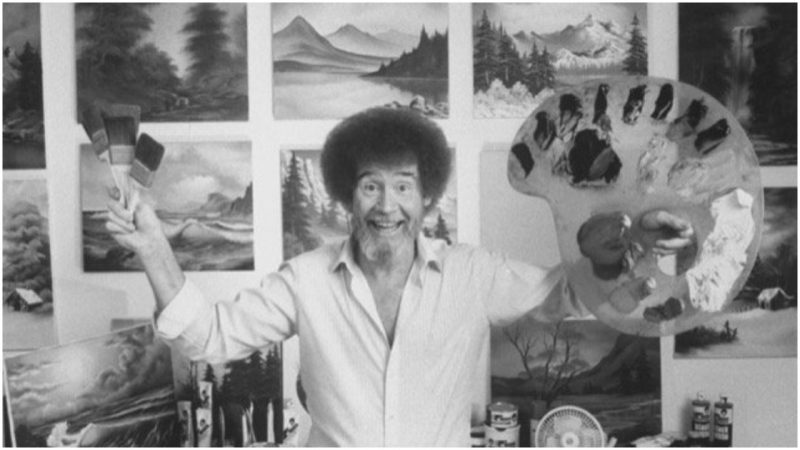“We don’t make mistakes, just happy little accidents”
A few years back, a couple of high profile streamers at Twitch.tv, the Amazon-owned video game streaming site, began a Bob Ross streaming marathon for their viewers with a clear intention of making a joke out of the beloved painter from the 1980s television show The Joy of Painting. By a happy little accident, they made him famous instead.
The “happy little trees” guy was an instant success and over the course of the next few days, he generated traffic to the site that is beyond belief. It’s reported that 5.6 million unique viewers tuned in and watched a combined total of 545,880,000 minutes during the Ross marathon. And just like that, his face was almost everywhere on the internet.
Apparently, people found the joyous landscape painting and Ross’s calming voice as soothing as it was back in the 1980s, when the show started. It ran until May 17, 1994, when after 403 episodes had been aired on PBS (Public Broadcasting Service), it sadly came to an end.
Every episode would show Bob with his halo-looking permed curly hair and partially unbuttoned bright colored shirt in front of the studio’s black backdrop as he took the large color palette in his left hand, hiding underneath his missing index finger (yes, Bob only had 4 fingers on his left hand). With soft, gentle taps sprayed over the white canvas, he would magically create an intricate landscape masterpiece in less then 30 minutes: Valley views, lazy rivers, misty waterfalls, seascapes with incandescent sunset skies, silent forest retreats, marshlands, and magical mountain ranges with happy little clouds on top of them.
Yes, with Bob, it was always about those happy little trees and fluffy clouds, and how easy it is to paint. “Anything that we don’t like, we’ll turn it into a happy little tree or something, because as you know, we don’t make mistakes, we just have happy little accidents. If you don’t like it, change it, it’s your world. In your world, you can do anything that you want. And maybe in our world, lives a happy little tree over there.”
The truth is, no one really watched Bob to learn painting skills, despite the fact that the whole purpose of his show was to make everyone believe can be an artist, as Bob would often say, “everyone can do what I do.”
As a matter of fact, his “wet on wet”technique and direct “alla prima”style of painting was adapted from another painter and television showrunner, William “Bill” Alexander who hosted The Magic of Oil Painting on PBS from 1974 to 1982, when Bob with his calming voice and comforting demeanor took over.
The ratings of the show grew overnight, yet almost 90 percent of the viewers were, in reality, watching Bob, well, just to watch Bob, and not paint along. While everyone could probably do what he did, not everyone could turn life’s mistakes into birds quite as easily as Bob could. With just a couple of brush strokes. “He just knew how to woo people with his profound aphorisms, it was like he was their liquid tranquilizer” is how his dear friend, long time business partner and personal manager Annette Kowalski described him once. With his creativity and calming nature, he was good for kids to watch as an afternoon special and a real break from all the negativity surrounding grown-ups. An alternate world and a peaceful refuge full of happy clouds and trees, outside of everyday life, it was different from every other dull television program.
Metaphors about life aside, Bob Ross was a prolific painter who painted more than 30,000 paintings in his life, 1,200 of them for the purpose of the show. For each specific episode, he would draw one before the show as a preparation, one during the actual filming, and one right after the show had ended that was painted in a more precise manner, and used for a photo shoot, educational “How to” guidelines, and various promotional activities. Every single one was royalty-free, half given to the Public Broadcasting Service Studios to auction them and raise funds in order to continue working, and the other half of “happy clouds and merry trees” were donated to charity.
Bob lived a “rag to riches” life, starting out in Florida with nothing. He lost his finger as a small boy while chopping wood with his father, but that didn’t stop him from becoming a Drill Sargent in the Air Force, and later in life did everything he could to pursue his main interest, painting, and live a life of positivity doing what he loved. His life motto was “Talent is only a pursuit interest. Anything that you are willing to practice over and over again, you can do.” He did not make a fortune from what he did, selling just a few paintings in order to make a living. When it comes to almost all of his other 28,000 and more, he gave them freely to everyone who was willing to visit his seminars, providing free instruction how to replicate them along the way.
Bob died on on July 4, 1995, a year after he was diagnosed with lymphoma and The Joy of Painting had ended. He was 52 years old and was lost in anonymity for a whole 20 years, until 2015, when a few gamers decided to stream him instead of playing games for their followers. In the end, maybe it wasn’t kids trying to poke fun at him. Maybe they were a few youngsters who, born in a different time, were sad for missing out on the purity of what Bob was and everything he represented. As a worthy remembrance, they brought him to life for a whole new audience, to live on as a virtual legend and a cultural meme, admired and celebrated by so many in their own little special ways.
